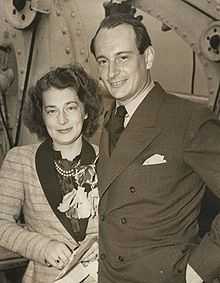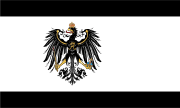Grand Duchess Kira Kirillovna of Russia
| Grand Duchess Kira Kirillovna | |||||
|---|---|---|---|---|---|
| Princess of Prussia | |||||
|
| |||||
| Spouse | Prince Louis Ferdinand of Prussia | ||||
| Issue |
Prince Friedrich Wilhelm Prince Michael Princess Marie Cécile Princess Kira Prince Louis Ferdinand Prince Christian-Sigismund Princess Xenia | ||||
| |||||
| House |
House of Holstein-Gottorp-Romanov (by birth) House of Hohenzollern (by marriage) | ||||
| Father | Grand Duke Cyril Vladimirovich of Russia | ||||
| Mother | Princess Victoria Melita of Saxe-Coburg and Gotha | ||||
| Born |
9 May 1909 Paris, France | ||||
| Died |
8 September 1967 (aged 58) Saint-Briac-sur-Mer, Brittany, France | ||||
Grand Duchess Kira Kirillovna of Russia (9 May 1909 – 8 September 1967) was the second daughter of Grand Duke Kirill Vladimirovich of Russia and Grand Duchess Victoria Feodorovna. She married Prince Louis Ferdinand of Prussia.
Russian Revolution
Kira, named after her father, was born in Paris while her parents were in exile. Her parents' marriage had not been approved by Tsar Nicholas II due to the fact that her maternal grandmother and paternal grandfather were siblings (the Russian Orthodox religion forbids the marriage of two first cousins), and so they had been forced to leave Russia. In addition, her mother had divorced her former husband, Ernst Ludwig, Grand Duke of Hesse, the brother of the Empress Alexandra. Her parents were later restored to favor and returned to Russia.

Following the Russian Revolution of 1917, the family fled to Finland. Kira, eight at the time, recalled that her family was permitted to leave by the Provisional Government of Russia. For the first time they rode on a public train. "For the first time there were no royal trappings ... i.e. red carpets, special comforts, etc.," she recalled.[1] In Finland, her 40-year-old mother gave birth to a son, Vladimir. The family waited in Finland for more than a year, hoping that the White Russians would defeat the Bolsheviks and they could return to Russia. "How I wish I could see you," 9-year-old Kira wrote to her aunt, Queen Marie of Romania, in May 1918. "Here it is quite cold though it ought to be summer. Boy (baby Vladimir) is so sweet. When he is hungry and Nana is preparing his lunch, the tears simply stream down his cheeks with hunger." Kira spoke of gathering mushrooms in the woods, going to the movies on Fridays, and of lessons, but also mentioned that they were running out of sugar. Her mother wrote to relatives in other countries begging for baby food to give the baby Vladimir.[2]
Later life
The family eventually left Finland and headed first to Coburg and then to Saint-Briac, France. Kira was born Princess Kira Kirillovna of Russia, but her father later gave her the title "Grand Duchess" when he declared himself Guardian of the Throne in 1924. Blonde-haired, blue-eyed[3] Kira, high-spirited and straightforward,[4] also had an even temper. She was intelligent, curious, and interested in the arts like her mother, with whom she worked in the art studio at Saint-Briac. Kira also frequently visited her cousins at various royal courts or attended house parties in the United Kingdom.[5] Kira had some difficulty finding a suitable husband. She was interested in the hemophiliac Alfonso of Spain, Prince of Asturias, son of Alfonso XIII of Spain, but was disappointed when the prince showed more interest in one of the daughters of Prince Nicholas of Greece. Later, she was fond of Prince Constantine "Teddy" Soutzo, a Romanian aristocrat. Her cousin, Carol II of Romania, refused to permit the match for political reasons.[6] Finally, Kira married Louis Ferdinand of Prussia in 1938. Louis Ferdinand worked with the underground against the Nazis, and, in the later years of the war, the couple was arrested and imprisoned at Dachau concentration camp, where they were rescued by American troops in 1945. They raised a family of four sons and three daughters in a village near Bremen, Germany.[4] Her children were:
- Prince Friedrich Wilhelm of Prussia (b. 9 February 1939)
- Prince Michael of Prussia (22 March 1940– 3 April 2014)
- Princess Marie Cécile of Prussia (b. 28 May 1942)
- Princess Kira of Prussia (27 June 1943 – 10 January 2004)
- Prince Louis Ferdinand of Prussia (25 August 1944 – 11 July 1977) m. Donata Countess of Castell-Rüdenhausen
- Prince Christian-Sigismund of Prussia (b. 14 March 1946)
- Princess Xenia of Prussia (9 December 1949 – 18 January 1992).[7]

After World War II, Kira was called upon to testify in the case of Anna Anderson, the woman who claimed to be Grand Duchess Anastasia Nikolaevna of Russia. Kira had met Anderson briefly in 1952 at the urging of her mother-in-law, Crown Princess Cecilie of Prussia, who believed Anderson's claim. Kira was not convinced. She found the woman "repellent" and "not a lady" and incapable of speaking the cultured English used by her family.[8] Kira had last seen Anastasia when she was a child of seven. Kira's uncle, Grand Duke Andrei Vladimirovich of Russia had been convinced Anderson was Anastasia, but her father and mother were unconvinced by Anderson's claim.[9]
In later years, Kira was disappointed when her eldest son, Friedrich Wilhelm, renounced his rights to the title and married a commoner.[10] She also paid little heed to her health, putting on weight and suffering from high blood pressure in her fifties. She was in good spirits on a visit to her brother Grand Duke Vladimir of Russia at Saint-Briac in September 1967, where she ate well and dumped several spoonfuls of sugar into her coffee, commenting, "God forbid I should eat anything healthy!" That night, she suffered a heart attack and soon died.[10]
Titles, styles and honours
- Titles
- 9 May 1909 - 8 August 1922: Her Highness Princess Kira Kirillovna of Russia
- 8 August 1922 - 21 October 1938: Her Imperial Highness Grand Duchess Kira Kirillovna of Russia
- 21 October 1938 - 20 July 1951: Her Imperial and Royal Highness Princess Kira, The Princess Louis Ferdinand of Prussia, Grand Duchess Kirillovna of Russia
- 20 July 1951 - 8 September 1967: Her Imperial and Royal Highness Princess Kira, The Princess of Prussia, Grand Duchess Kirillovna of Russia[11]
- National dynastic honours
-
 Russian Imperial Family: Knight Grand Cross of the Order of St. Andrew[12]
Russian Imperial Family: Knight Grand Cross of the Order of St. Andrew[12] -
 Russian Imperial Family: Dame of the Order of St Catherine
Russian Imperial Family: Dame of the Order of St Catherine -
 German/Prussian Imperial and Royal family: Knight Grand Cross of the Order of the Black Eagle[13]
German/Prussian Imperial and Royal family: Knight Grand Cross of the Order of the Black Eagle[13] -
 German/Prussian Imperial and Royal family: Grand Mistress Dame of the Order of Louise[14]
German/Prussian Imperial and Royal family: Grand Mistress Dame of the Order of Louise[14]
Ancestry
Notes
- ↑ Michael John Sullivan, A Fatal Passion: The Story of the Uncrowned Last Empress of Russia, Random House, 1997, p. 322
- ↑ Sullivan, p. 333
- ↑ Sullivan, p. 378
- ↑ 4.0 4.1 Sullivan, p. 408
- ↑ John Van der Kiste, Princess Victoria Melita, Sutton Publishing, 1991, p. 141
- ↑ Van der Kiste, p. 141
- ↑ Paul Theroff (2007). "Prussia". An Online Gotha. Retrieved 7 January 2007.
- ↑ Peter Kurth, Anastasia: The Riddle of Anna Anderson, Back Bay Books, 1983, p. 343
- ↑ Kurth, p. 342
- ↑ 10.0 10.1 Van der Kiste, p. 160
- ↑ http://www.preussen.de/en/family/family_tree/louis_ferdinand_sen._prince_of_prussia.html?cpid=751
- ↑ http://forum.alexanderpalace.org/index.php?topic=13367.15
- ↑ https://www.pinterest.com/pin/290271138457086398/
- ↑ http://25.media.tumblr.com/tumblr_lkf950Ot1I1qcfftgo1_1280.jpg
References
- Peter Kurth, Anastasia: The Riddle of Anna Anderson, Back Bay Books, 1983, ISBN 0-316-50717-2
- Michael John Sullivan, A Fatal Passion: The Story of the Uncrowned Last Empress of Russia, Random House, 1997, ISBN 0-679-42400-8
- John Van der Kiste, Princess Victoria Melita, Sutton Publishing, 1991, ISBN 0-7509-3469-7
| Grand Duchess Kira Kirillovna of Russia Cadet branch of the House of Oldenburg Born: 9 May 1909 Died: 8 September 1967 | ||
| Titles in pretence | ||
|---|---|---|
| Preceded by Duchess Cecilie of Mecklenburg-Schwerin |
— TITULAR — German Empress Queen of Prussia 20 July 1951 – 8 September 1967 Reason for succession failure: German monarchies abolished in 1918 |
Vacant Title next held by Princess Sophie of Isenburg |
| ||||||||||||||||||||||||||||||||||||||||||
| ||||||||||||||||||||||||||||||||||||||||||||||||||||||